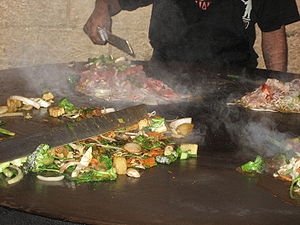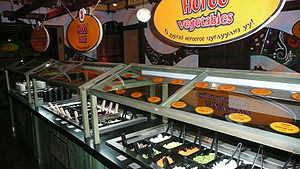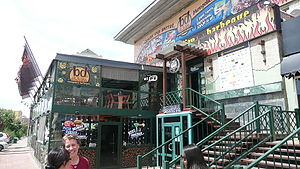
Mongolian barbecue
Encyclopedia

Stir frying
Stir frying is an umbrella term used to describe two Chinese cooking techniques for preparing food in a wok: chǎo and bào . The term stir-fry was introduced into the English language by Buwei Yang Chao, in her book How to Cook and Eat in Chinese, to describe the chǎo technique...
dish that was developed in Taiwan
Taiwan
Taiwan , also known, especially in the past, as Formosa , is the largest island of the same-named island group of East Asia in the western Pacific Ocean and located off the southeastern coast of mainland China. The island forms over 99% of the current territory of the Republic of China following...
ese restaurants in the 1970s. Meat and vegetables are cooked in large, round, solid iron griddle
Griddle
A griddle is a cooking device consisting of a broad flat surface that can be heated using a variety of means, and is used in both residential and commercial applications for a variety of cooking operations. Most commonly, the griddle consists of a flat metal plate, but in the non-industrialized...
s at temperatures of up to 300 °C (572 °F). Despite its name, the cuisine is not Mongolian
Mongolian cuisine
Mongolian cuisine refers to the local culinary traditions of Mongolia and Mongolian styled dishes. The extreme continental climate has affected the traditional diet, so the Mongolian cuisine primarily consists of dairy products, meat, and animal fats. Use of vegetables and spices is limited...
, and is only very loosely related to barbecue
Barbecue
Barbecue or barbeque , used chiefly in the United States, Canada, the United Kingdom, New Zealand and Australia is a method and apparatus for cooking meat, poultry and occasionally fish with the heat and hot smoke of a fire, smoking wood, or hot coals of...
.
Origins
Although Mongolian barbecue first appeared in Taiwan in the middle to late 20th century, the stir-frying of meats on a large, open surface is supposed to evoke Mongolian foods and Mongolian traditions. The preparation can also derive from JapaneseJapanese cuisine
Japanese cuisine has developed over the centuries as a result of many political and social changes throughout Japan. The cuisine eventually changed with the advent of the Medieval age which ushered in a shedding of elitism with the age of shogun rule...
-style teppanyaki
Teppanyaki
is a style of Japanese cuisine that uses an iron griddle to cook food. The word teppanyaki is derived from teppan , which means iron plate, and yaki , which means grilled, broiled or pan-fried...
, which was popular in Taiwan at the time. The very first Mongolian Barbecue restaurant (Gengis Khan Mongolian BBQ) was opened in 1976, and was located in downtown Taipei, Taiwan.
American restaurants such as HuHot Mongolian Grill
HuHot Mongolian Grill
HuHot Mongolian Grill is an American restaurant chain specializing in a pan-Asian create-your-own stir fry cuisine. Based in Missoula, Montana, there are currently 39 HuHot Mongolian Grills in 14 states, the vast majority located in the Midwest and the Mountain West states.-HuHot Mongolian Grill...
and BD's Mongolian Barbeque
BD's Mongolian Barbeque
BD's Mongolian Grill is an American restaurant chain specializing in patron-prepared stir-fry meals in a style known as "Mongolian barbecue". Grillers use 3-foot metal "swords" and cook on an 8-foot diameter gas flat top grill reaching temperatures of 600 degrees Fahrenheit .BD's was founded in...
claim that soldiers of the Mongol Empire
Mongol Empire
The Mongol Empire , initially named as Greater Mongol State was a great empire during the 13th and 14th centuries...
gathered large quantities of meats, prepared them with their swords and cooked them on their overturned shields over a large fire. A German
German cuisine
German cuisine is a style of cooking derived from the nation of Germany. It has evolved as a national cuisine through centuries of social and political change with variations from region to region. The southern regions of Germany, including Bavaria and neighbouring Swabia, share many dishes....
restaurant chain with the same concept claims that the Mongolian soldiers cooked their meals on a heated stone.

Preparation
Typically, diners choose various ingredients from a buffetBuffet
A buffet is a system of serving meals in which food is placed in a public area where the diners generally serve themselves. Buffets are offered at various places including hotels and many social events...
of thinly sliced raw meats (beef
Beef
Beef is the culinary name for meat from bovines, especially domestic cattle. Beef can be harvested from cows, bulls, heifers or steers. It is one of the principal meats used in the cuisine of the Middle East , Australia, Argentina, Brazil, Europe and the United States, and is also important in...
, pork
Pork
Pork is the culinary name for meat from the domestic pig , which is eaten in many countries. It is one of the most commonly consumed meats worldwide, with evidence of pig husbandry dating back to 5000 BC....
, lamb, turkey
Turkey
Turkey , known officially as the Republic of Turkey , is a Eurasian country located in Western Asia and in East Thrace in Southeastern Europe...
, chicken
Chicken
The chicken is a domesticated fowl, a subspecies of the Red Junglefowl. As one of the most common and widespread domestic animals, and with a population of more than 24 billion in 2003, there are more chickens in the world than any other species of bird...
, shrimp
Shrimp
Shrimp are swimming, decapod crustaceans classified in the infraorder Caridea, found widely around the world in both fresh and salt water. Adult shrimp are filter feeding benthic animals living close to the bottom. They can live in schools and can swim rapidly backwards. Shrimp are an important...
) and vegetables (cabbage
Cabbage
Cabbage is a popular cultivar of the species Brassica oleracea Linne of the Family Brassicaceae and is a leafy green vegetable...
, tofu
Tofu
is a food made by coagulating soy milk and then pressing the resulting curds into soft white blocks. It is part of East Asian and Southeast Asian cuisine such as Chinese, Japanese, Korean, Indonesian, Vietnamese, and others. There are many different varieties of tofu, including fresh tofu and tofu...
, sliced onion
Onion
The onion , also known as the bulb onion, common onion and garden onion, is the most widely cultivated species of the genus Allium. The genus Allium also contains a number of other species variously referred to as onions and cultivated for food, such as the Japanese bunching onion The onion...
, cilantro, broccoli
Broccoli
Broccoli is a plant in the cabbage family, whose large flower head is used as a vegetable.-General:The word broccoli, from the Italian plural of , refers to "the flowering top of a cabbage"....
, and mushrooms, pineapple
Pineapple
Pineapple is the common name for a tropical plant and its edible fruit, which is actually a multiple fruit consisting of coalesced berries. It was given the name pineapple due to its resemblance to a pine cone. The pineapple is by far the most economically important plant in the Bromeliaceae...
, lychee
Lychee
The lychee is the sole member of the genus Litchi in the soapberry family, Sapindaceae. It is a tropical and subtropical fruit tree native to Southern China and Southeast Asia, and now cultivated in many parts of the world...
, bowl or on a plate. These ingredients are given to the griddle operator who adds the diner's choice of sauce and transfers them to one section of the hot griddle. Oil and sometimes water may be added to ease cooking, and the ingredients are stirred occasionally.
The ample size of the Mongolian barbecue griddle allows for several diners' food to be cooked simultaneously on different parts of the griddle. In many restaurants (primarily buffets) one dish will be cooked at a time, the operator walking around the outside of the grill once or twice moving the food while walking. When cooking is complete, the finished dish is scooped into a bowl and handed to the diner. Many Mongolian barbecue restaurants are "all-you-can-eat."
Restaurants

Khagan
Khagan or qagan , alternatively spelled kagan, khaghan, qaghan, or chagan, is a title of imperial rank in the Mongolian and Turkic languages equal to the status of emperor and someone who rules a khaganate...
(Mongolian: Их Хаан)(大可汗) or Temüjin
Genghis Khan
Genghis Khan , born Temujin and occasionally known by his temple name Taizu , was the founder and Great Khan of the Mongol Empire, which became the largest contiguous empire in history after his death....
(Mongolian: Тэмужин)(鐵木真). The peak popularity of these restaurants was in the 1980s and 1990s.
In the United States
United States
The United States of America is a federal constitutional republic comprising fifty states and a federal district...
, Mongolian barbecue is often found in American Chinese
American Chinese cuisine
American Chinese cuisine refers to the style of food served by many Chinese restaurants in the United States. This type of cooking typically caters to Western tastes, and differs significantly from the original Chinese cuisine.-History:...
buffet
Buffet
A buffet is a system of serving meals in which food is placed in a public area where the diners generally serve themselves. Buffets are offered at various places including hotels and many social events...
restaurants, but some businesses such as HuHot Mongolian Grill , North Carolina's Crazy Fire Mongolian Grill, and BD's Mongolian Barbeque
BD's Mongolian Barbeque
BD's Mongolian Grill is an American restaurant chain specializing in patron-prepared stir-fry meals in a style known as "Mongolian barbecue". Grillers use 3-foot metal "swords" and cook on an 8-foot diameter gas flat top grill reaching temperatures of 600 degrees Fahrenheit .BD's was founded in...
chain
Chain store
Chain stores are retail outlets that share a brand and central management, and usually have standardized business methods and practices. These characteristics also apply to chain restaurants and some service-oriented chain businesses. In retail, dining and many service categories, chain businesses...
focus primarily on the barbecue. Genghis Grill, Y.C.'s Mongolian Grill, and Hula's are other chains of restaurants with this type of fare.
Fire + Ice is an American restaurant chain that expands upon the concept, with a much larger selection of raw ingredients from many cultures, a variety of Asian, European, and Latin American sauces, and a large annular
Annulus (mathematics)
In mathematics, an annulus is a ring-shaped geometric figure, or more generally, a term used to name a ring-shaped object. Or, it is the area between two concentric circles...
cooking surface.
The Mongolian Barbeque is a chain with locations in Europe and the Middle East. With BD's Mongolian Barbeque a first similar restaurant has been opened also in Mongolia's capital Ulaanbaatar.
Jingisukan
In Japan, a similar dish to Mongolian barbecue called (Mongolian: Chinggis Khaan "Чингис Хаан") is prepared with mutton and cooked on a convex metal skillet. The dish is particularly popular on the northern island of HokkaidōHokkaido
, formerly known as Ezo, Yezo, Yeso, or Yesso, is Japan's second largest island; it is also the largest and northernmost of Japan's 47 prefectural-level subdivisions. The Tsugaru Strait separates Hokkaido from Honshu, although the two islands are connected by the underwater railway Seikan Tunnel...
. The dish is rumored to be so named because in prewar Japan, lamb was widely thought to be the meat of choice among Mongolian soldiers, and the dome-shaped skillet is meant to represent the soldier's helmets that they purportedly used to cook their food.
See also
- Mongolian cuisineMongolian cuisineMongolian cuisine refers to the local culinary traditions of Mongolia and Mongolian styled dishes. The extreme continental climate has affected the traditional diet, so the Mongolian cuisine primarily consists of dairy products, meat, and animal fats. Use of vegetables and spices is limited...
- "KhorkhogKhorkhogKhorkhog is a traditional Mongolian barbecue dish and an authentic example of Mongolian cuisine. Khorkhog is made by cooking pieces of meat inside a container which also contains hot stones and water, and is often also heated from the outside.-Preparation:...
", an authentic "Mongolian barbecue" meal. - Korean BBQ, galbi refers to a variety of grilled dishes in Korean cuisine.
- BulgogiBulgogiBulgogi is a Korean dish that usually consists of marinated barbecued beef, although chicken or pork may also be used. It is listed at number 23 on World's 50 most delicious foods readers' poll complied by CNN Go in 2011.-Etymology:...
, popular Korean stirred-fry grill and similar with Mongolian barbecue. - Saj, a convex griddle used in central, south, and west Asia for cooking bread and meat

